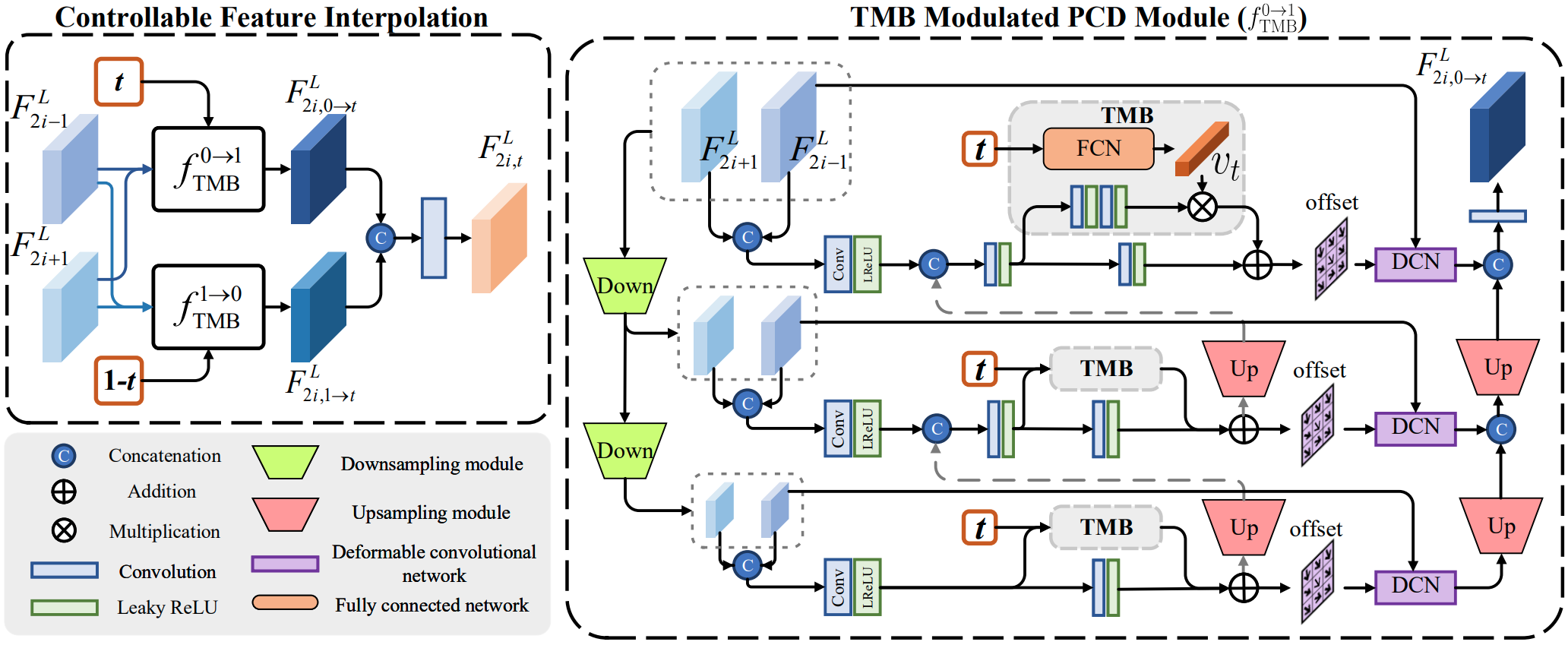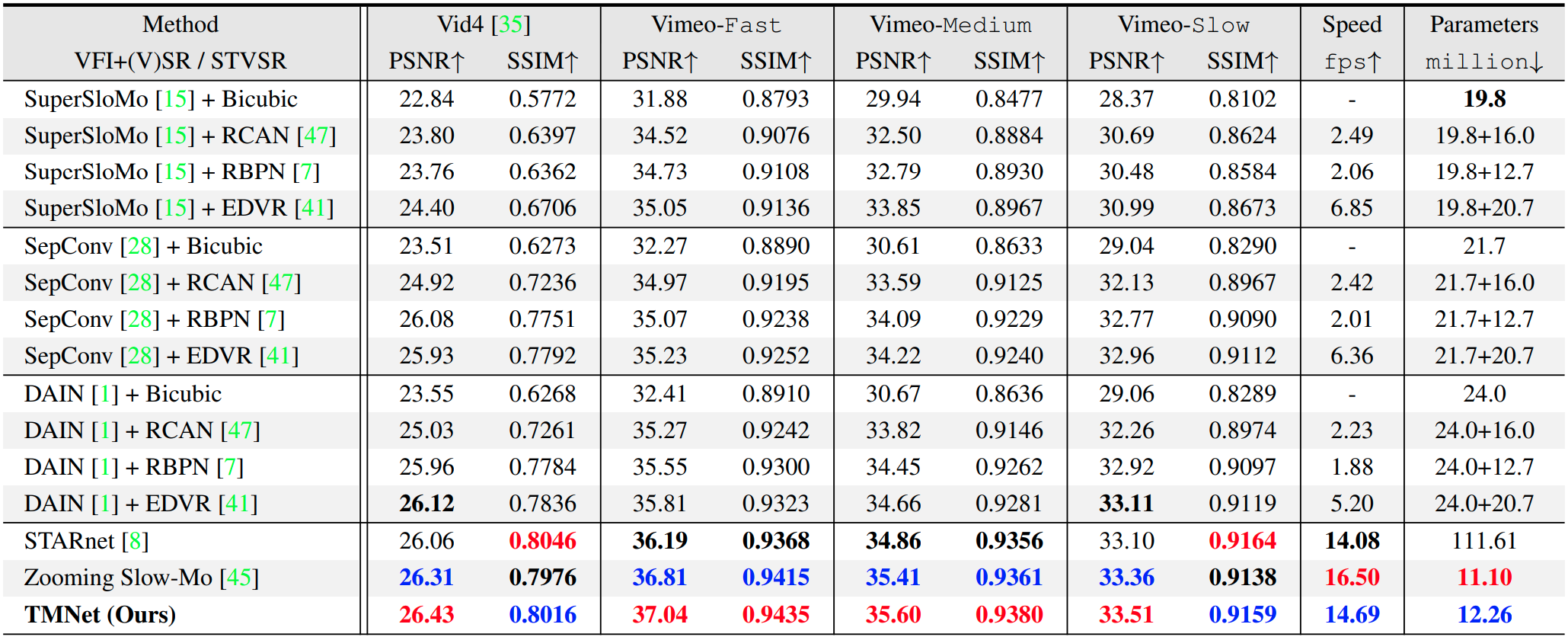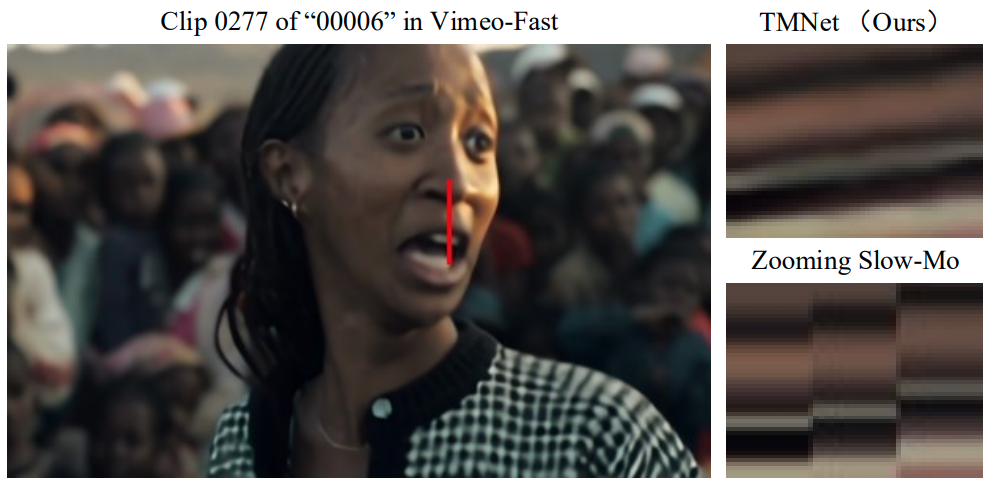This is the official PyTorch implementation of TMNet in the CVPR 2021 paper "Temporal Modulation Network for Controllable Space-Time Video Super-Resolution". Our TMNet can flexibly interpolate intermediate frames for space-time video super-resolution (STVSR).
- 2021.06.17 Dataset preparation for Adobe240fps and Vid4 Dataset
- 2021.05.08 Upload the code of training and testing.
- 2021.04.23 Init the repositories.
Space-time video super-resolution (STVSR) aims to increase the spatial and temporal resolutions of low-resolution and low-frame-rate videos. Recently, deformable convolution based methods have achieved promising STVSR performance, but they could only infer the intermediate frame pre-defined in the training stage. Besides, these methods undervalued the short-term motion cues among adjacent frames. In this paper, we propose a Temporal Modulation Network (TMNet) to interpolate arbitrary intermediate frame(s) with accurate high-resolution reconstruction. Specifically, we propose a Temporal Modulation Block (TMB) to modulate deformable convolution kernels for controllable feature interpolation. To well exploit the temporal information, we propose a Locally-temporal Feature Comparison (LFC) module, along with the Bi-directional Deformable ConvLSTM, to extract short-term and long-term motion cues in videos. Experiments on three benchmark datasets demonstrate that our TMNet outperforms previous STVSR methods.
- Python 3.6
- PyTorch >= 1.1
- NVIDIA GPU + CUDA
- Deformable Convolution v2, we adopt CharlesShang's implementation in the submodule.
- Python packages:
pip install numpy opencv-python lmdb pyyaml pickle5 matplotlib seaborn
git clone https://github.com/CS-GangXu/TMNet.git
You should first set configuration of the $ROOT/models/modules/DCNv2/make.sh
#!/usr/bin/env bash
# You may need to modify the following paths before compiling.
CUDA_HOME=/usr/local/cuda-10.0 \
CUDNN_INCLUDE_DIR=/usr/local/cuda-10.0/include \
CUDNN_LIB_DIR=/usr/local/cuda-10.0/lib64 \
python setup.py build develop
Then, run the make.sh:
cd $ROOT/models/modules/DCNv2
bash make.sh
You need to prepare datasets for following training and testing activities, the detailed information is at Dataset Setup.
Our pretrained models (tmnet_single_frame.pth and tmnet_multiple_frames.pth) can be downloaded via Google Drive or Baidu Netdisk(access code: wiq7). After you download the pretrained models, please put them into the $ROOT/checkpoints folder.
Our training settings in the paper can be found at $ROOT/configs/TMNet_single_frame.yaml and $ROOT/configs/TMNet_multiple_frames.yaml . We'll take these settings as an example to illustrate our training strategy in our paper.
We need to train the TMNet without the TMB block on the Vimeo-90K Septuplet dataset. Thus we need to follow the configuration in $ROOT/configs/TMNet_single_frame.yaml.
If you want to train the TMNet without distributed learning:
python train.py -opt configs/TMNet_single_frame.yaml
If you want to train the TMNet with distributed learning ($GPU_NUMBER means the number of GPUs you used):
python -m torch.distributed.launch --nproc_per_node=$GPU_NUMBER train.py -opt configs/TMNet_single_frame.yaml --launcher pytorch
We need to fintune the TMB block for temporal modulation on the Adobe240fps dataset with the other parameters being fixed. Thus we need to follow the configuration in $ROOT/configs/TMNet_multiple_frames.yaml.
If you want to train the TMNet without distributed learning:
python train.py -opt configs/TMNet_multiple_frames.yaml
If you want to train the TMNet with distributed learning ($GPU_NUMBER means the number of GPUs you used):
python -m torch.distributed.launch --nproc_per_node=$GPU_NUMBER train.py -opt configs/TMNet_multiple_frames.yaml --launcher pytorch
After training, the model, its training states and a corresponding log file are placed in the directory of $ROOT/experiments.
You can evaluate the performance of the trained TMNet for single frame generation at the intermediate moment using the Vimeo-90k Septuplet dataset (for example, if we input a video with 30fps as the input, this code takes the generated video with 60fps for evaluation):
python test_single_frame.py
You can evaluate the performance of the trained TMNet for multiple (x6) frames generation using the Adobe240fps dataset (for example, if we input a video with 30fps as the input, this code takes the generated video with 180fps for evaluation):
python test_multiple_frames.py
All the evaluation results are placed in to $ROOT/evaluations
Comparison of PSNR, SSIM, speed (in fps), and parameters (in million) by different STVSR methods on Vid4, Vimeo-Fast, Vimeo-Medium, Vimeo-Slow:
Qualitative and quantitative results of different methods on STVSR:
Comparison of flexibility on STVSR by our TMNet (1-st, 3-rd, and 5-th columns) and Zooming Slow-Mo (2-nd, 4-th, and 6-th columns) on three video clips from the Vimeo-Fast dataset:
Temporal consistency of our TMNet on STVSR:
If you find the code helpful in your research or work, please cite our paper.
@InProceedings{xu2021temporal,
author = {Gang Xu and Jun Xu and Zhen Li and Liang Wang and Xing Sun and Mingming Cheng},
title = {Temporal Modulation Network for Controllable Space-Time Video Super-Resolution},
booktitle = {IEEE/CVF Conference on Computer Vision and Pattern Recognition (CVPR)},
month = {June},
year = {2021}
}Our code is built on Zooming-Slow-Mo-CVPR-2020 and EDVR. We thank the authors for sharing their codes. Our project is sponsored by CAAI-Huawei MindSpore Open Fund.
If you have any questions, feel free to E-mail me with gangxu@mail.nankai.edu.cn.
The code is released under the Creative Commons Attribution-NonCommercial-ShareAlike 4.0 International Public License for NonCommercial use only. Any commercial use should get formal permission first.






